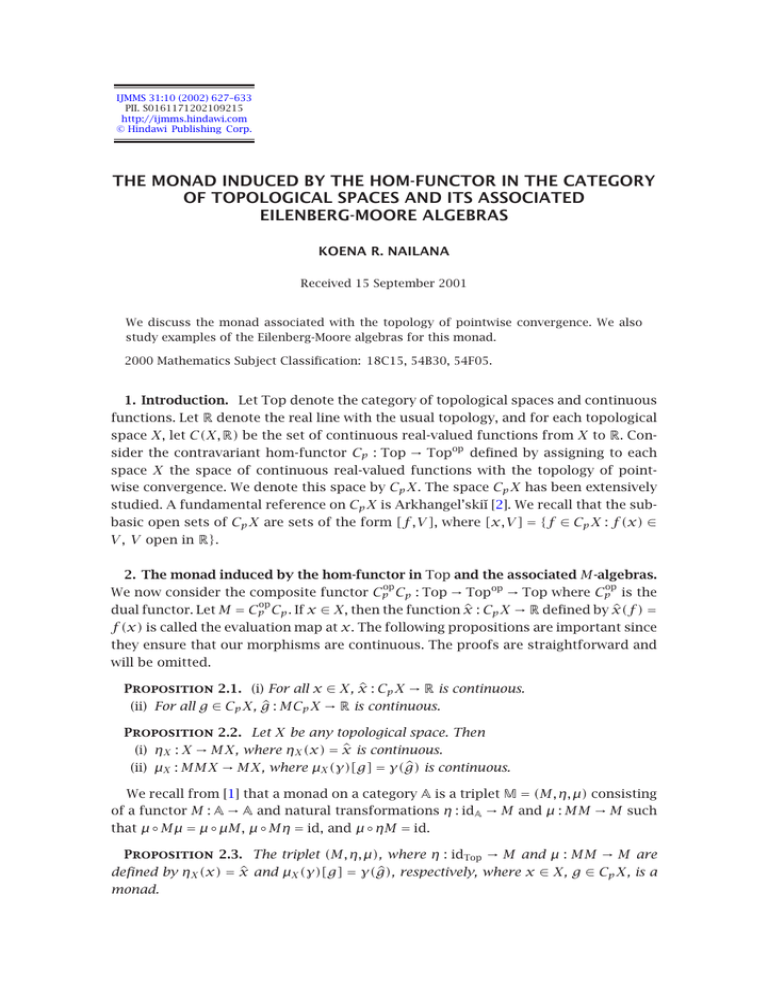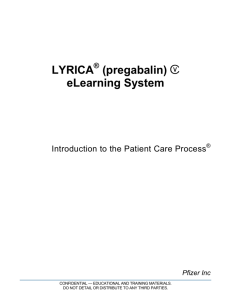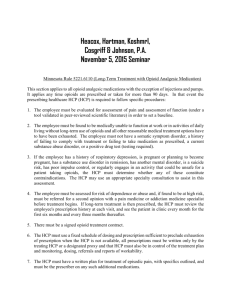THE MONAD INDUCED BY THE HOM-FUNCTOR IN THE CATEGORY EILENBERG-MOORE ALGEBRAS
advertisement

IJMMS 31:10 (2002) 627–633
PII. S0161171202109215
http://ijmms.hindawi.com
© Hindawi Publishing Corp.
THE MONAD INDUCED BY THE HOM-FUNCTOR IN THE CATEGORY
OF TOPOLOGICAL SPACES AND ITS ASSOCIATED
EILENBERG-MOORE ALGEBRAS
KOENA R. NAILANA
Received 15 September 2001
We discuss the monad associated with the topology of pointwise convergence. We also
study examples of the Eilenberg-Moore algebras for this monad.
2000 Mathematics Subject Classification: 18C15, 54B30, 54F05.
1. Introduction. Let Top denote the category of topological spaces and continuous
functions. Let R denote the real line with the usual topology, and for each topological
space X, let C(X, R) be the set of continuous real-valued functions from X to R. Consider the contravariant hom-functor Cp : Top → Topop defined by assigning to each
space X the space of continuous real-valued functions with the topology of pointwise convergence. We denote this space by Cp X. The space Cp X has been extensively
studied. A fundamental reference on Cp X is Arkhangel’skiı̆ [2]. We recall that the subbasic open sets of Cp X are sets of the form [f , V ], where [x, V ] = {f ∈ Cp X : f (x) ∈
V , V open in R}.
2. The monad induced by the hom-functor in Top and the associated M-algebras.
op
op
We now consider the composite functor Cp Cp : Top → Topop → Top where Cp is the
op
: Cp X → R defined by x(f
)=
dual functor. Let M = Cp Cp . If x ∈ X, then the function x
f (x) is called the evaluation map at x. The following propositions are important since
they ensure that our morphisms are continuous. The proofs are straightforward and
will be omitted.
: Cp X → R is continuous.
Proposition 2.1. (i) For all x ∈ X, x
: MCp X → R is continuous.
(ii) For all g ∈ Cp X, g
Proposition 2.2. Let X be any topological space. Then
is continuous.
(i) ηX : X → MX, where ηX (x) = x
is continuous.
(ii) µX : MMX → MX, where µX (γ)[g] = γ(g)
We recall from [1] that a monad on a category A is a triplet M = (M, η, µ) consisting
of a functor M : A → A and natural transformations η : idA → M and µ : MM → M such
that µ ◦ Mµ = µ ◦ µM, µ ◦ Mη = id, and µ ◦ ηM = id.
Proposition 2.3. The triplet (M, η, µ), where η : idTop → M and µ : MM → M are
and µX (γ)[g] = γ(g),
respectively, where x ∈ X, g ∈ Cp X, is a
defined by ηX (x) = x
monad.
628
KOENA R. NAILANA
Proof. We first check that η : idTop → M and µ : MM → M are natural transformations. Let f : X → Y be a continuous function. We show that M(f ) ◦ ηX = ηY ◦ f .
and M(f )(γ)[g] = γ(g ◦ f ) where g : Y → R
We define ηX and M(f ) by ηX (x) = x
is continuous, γ ∈ M(X), and denotes evaluation, for example, x(g)
= g(x). Then
Let g ∈ Cp X. Then M(f )(x)[g]
◦ f ) = g ◦ f (x) =
= x(g
M(f ) ◦ ηX (x) = M(f )(x).
= f
(x)[g]. Hence M(f )(x)
(x). Now ηY ◦ f (x) = ηY (f (x)) = f
(x).
g(f (x)) = f
Let g ∈ Cp X. Then f
(x)[g] = g(f (x)). Hence M(f ) ◦ ηX = ηY ◦ f . We define µX by
where γ ∈ MM(X), g ∈ Cp X, and g
denotes the evaluation function
µX (γ)[g] = γ(g)
: M(X) → R. We now show that µ : MM → M is a natural transformation,
at g, that is, g
that is, M(f ) ◦ µX = µY ◦ M 2 (f ). Let h ∈ Cp Y . Then
◦f .
M(f ) ◦ µX (γ)[h] = M(f ) µX (γ) [h] = µX (γ)(h ◦ f ) = γ h
(2.1)
On the other hand,
µY ◦ M 2 (f )(γ)[h] = µY M 2 (f )(γ) [h]
= M 2 (f )(γ) h
= M M(f ) (γ) h
◦ M(f ) .
=γ h
(2.2)
◦ M(f ))(λ) = h(M(f
)(λ)) = M(f )(λ)[h] = λ(h ◦ f ) =
Let λ : Cp X → R. Then (h
h ◦ f (λ). Therefore, h ◦ M(f ) = h ◦ f . From the equations
M(f ) ◦ µX (γ)[h] = γ h
◦f ,
◦ M(f ) ,
µY ◦ M 2 (f )(γ)[h] = γ h
◦ M(f ) (λ) = h
◦ f (λ),
h
(2.3)
we get M(f ) ◦ µX = µY ◦ M 2 (f ). Therefore µ : MM → M is a natural transformation. We now show that the other monad conditions are satisfied. First, we show
that µX ◦ Mη = id. We prove that µX ◦ Mη = id and µX ◦ ηM = id. Let γ ∈ M(X) and
f ∈ Cp X. Then f : M(X) → R and (µX ◦ Mη)(γ) ∈ M(X). Then (µX ◦ Mη)(γ)[f ] =
µX (Mη(γ))[f ] = Mη(γ)(f) = γ(f ◦ η) = γ[f ]. Therefore µX ◦ Mη = id. On the other
f) = f(γ) = γ(f ). Therefore
hand (µX ◦ ηM )(γ)[f ] = µX (ηM )(γ)[f ] = ηM (γ)[f] = γ(
µX ◦ ηM = id. Second, we show that µX ◦ µM = µX ◦ MµX . We prove that µX ◦ µM =
µX ◦ MµX . Let γ ∈ MMM(X). Then µX ◦ MµX (γ) ∈ M(X). Let f ∈ Cp X. Then (µX ◦
MµX )(γ)[f ] = µX (MµX (γ))[f ] = MµX (γ)[f] = γ(f ◦ µX ) = γ(f). On the other hand,
(µX ◦ µM )(γ)[f ] = µX (µM (γ))[f ] = µM (γ)(f) = γ(f). Therefore µX ◦ µM = µX ◦ MµX .
Therefore (M, η, µ) is a monad.
If M = (M, η, µ) is a monad on A, then (A, hA ) is called an Eilenberg-Moore algebra
or simply an M-algebra if the algebra map hA : MA → A satisfies hA ◦ ηA = idA and
hA ◦ MhA = hA ◦ µA .
We now look at examples of the M-algebras of the monad (M, η, µ).
629
EILENGBERG-MOORE ALGEBRAS
Proposition 2.4. The real line R is an M-algebra.
R , that is, the identity map with respect to
Proof. We define hR : MR → R as 1
R, and show that the M-algebra conditions are satisfied. It is obvious that the map
= x(1
R ) = 1R (x). Therefore
hR is continuous. Let x ∈ R. Then hR ◦ ηR (x) = hR (x)
R ).
hR ◦ηR = 1R . Now let γ ∈ MM(R). Then hR ◦µR (γ) = 1R (µR (γ)) = µR (γ)(1R ) = γ(1
On the other hand, hR ◦ MhR (γ) = 1R (M 1R (γ)) = 1R (γ ◦ Cp (1R )) = γ ◦ Cp (1R )(1R ) =
R )(1R )) = γ(1R ◦ 1
R ) = γ(1
R ). Therefore hR ◦ µR = hR ◦ MhR .
γ(Cp (1
Proposition 2.5. For each X ∈ Top, Cp X is an M-algebra with hCp X = Cp (ηX ).
Proof. We first define hCp X : MCp X → Cp X. Let ϕ ∈ MCp X. We define hCp X by
hCp X (ϕ) = ϕ ◦ ηX = Cp ηX (ϕ). Then the map hCp X is continuous, since it is the composite of continuous functions ϕ and ηX . We now show that the conditions for an
M-algebra are satisfied. Thus, we must show that hCp X ◦ ηCp X = idCp X . Let f ∈ Cp X.
Then hC X ◦ ηC X (f ) = hC X (ηC X (f )) = Cp ηX (f) = f ◦ ηX = f = idC X (f ), since
p
p
p
p
p
) = f (x). Therefore hCp X ◦ ηCp X = idCp X .
f ◦ ηX (x) = f(ηX (x)) = x(f
We must now show that hCp X ◦ µCp X = hCp X ◦ MhCp X . Let γ ∈ MMCp X. Then hCp X ◦
µCp X (γ) = hCp X (µCp X (γ)) = Cp ηX (µCp X (γ)) = µCp X (γ) ◦ ηX . Now let x ∈ X. Then
On the other hand, hC X ◦ MhC X (γ) = Cp ηX ◦
= γ(x).
µC X (γ) ◦ ηX (x) = µC X (γ)(x)
p
p
p
p
MCp ηX (γ) = Cp (MηX ◦ηX )(γ) = γ ◦MηX ◦ηX . Let x ∈ X. Then MηX ◦ηX (x) = MηX (x)
Therefore hC X ◦ µC X = hC X ◦ MhC X . Hence Cp X is an M-algebra.
◦ Cp ηX = x.
=x
p
p
p
p
Proposition 2.6. Retracts of Cp X are M-algebras.
Proof. Let g : Cp Y → X be a retraction. Then there is a continuous function f :
X → Cp Y such that g ◦ f = idX . The following diagram will help us define the algebra
map hX : MX → X:
X
ηX
MX
Mf
MCp Y
Cp ηY
Cp Y
Mg
idMX
MX
g
idX
(2.4)
hX
X
Define
hX = g ◦ Cp η ◦ Mf = g ◦ Cp Cp f ◦ ηY .
Since hX is the composite of continuous functions, then it is continuous.
(2.5)
630
KOENA R. NAILANA
Now,
= g C Cf ◦ ηY x
=g x
◦ Cf ◦ ηY
hX ◦ ηX (x) = hX x
(x) ◦ ηY = g f (x) = idX (x),
= g f
since g is a retraction.
We now show that hX ◦ µX = hX ◦ MhX . Let γ ∈ MMX. Then
hX ◦ µX (γ) = hX µX (γ) = g ◦ Cp Cp f ◦ ηY µX (γ)
= g Cp Cp f ◦ ηY µX (γ) = g µX (γ) ◦ Cp f ◦ ηY .
If k ∈ Cp X, then
.
µX (γ)(k) = γ k
(2.6)
(2.7)
(2.8)
On the other hand,
hX ◦ MhX = g ◦ Cp Cp f ◦ ηY ◦ M g ◦ Cp Cp f ◦ ηY
= g ◦ Cp ηY ◦ Mf ◦ Mg ◦ MCp Cp f ◦ ηY
= g ◦ Cp ηY ◦ M(f ◦ g) ◦ MCp Cp f ◦ ηY
= g ◦ Cp ηY ◦ M idX ◦ MCp Cp f ◦ ηY
= g ◦ Cp ηY ◦ MCp Cp f ◦ ηY
= g ◦ Cp M Cp f ◦ ηY ◦ ηY
= g ◦ Cp ηCp X ◦ Cp f ◦ ηY .
(2.9)
Now,
hX ◦ MhX (γ) = g Cp ηCp X ◦ Cp f ◦ ηY (γ)
= g γ ◦ ηCp X ◦ Cp f ◦ ηY .
(2.10)
We only need to show that γ ◦ηCp X = µX . Let k ∈ Cp X. Then γ ◦ηCp X (k) = γ(ηCp X (k))
From (2.8), we have γ ◦ ηC X = µX and therefore hX ◦ µX = hX ◦ MhX . Hence
= γ(k).
p
retracts of Cp X are M-algebras.
3. The algebra morphisms and the transfer of ring structure from MX to X for
an M-algebra (X, hX ). For an M-algebra (X, hX ) the ring structure on MX can be
transferred to X, via hX , in such a way that X becomes a ring with respect to the
induced operations.
Definition 3.1. On an M-algebra (X, hX ) define
(i) x1 + x2 to be hX (ηX (x1 ) + ηX (x2 )),
(ii) x1 · x2 to be hX (ηX (x1 ) · ηX (x2 )).
In addition to the ring structure defined above we also define the scalar multiplication in the following way: define tx to be hX (tηX (x)), where t is a scalar.
According to Definition 3.1, Cp X (being an M-algebra, Proposition 2.5) has now two
concepts of the operations “+” and “·”, the natural one defined pointwise
hX (x + y) = hX (x) + hX (y), hX (xy) = hx (x)hX (y)
(3.1)
EILENGBERG-MOORE ALGEBRAS
631
and Definition 3.1. The same applies to MX. We omit the straightforward proof of the
following proposition.
Proposition 3.2. The natural operations on MX defined pointwise coincide with
the corresponding ones defined above.
Lemma 3.3. The topology on X is initial with respect to ηX , that is, X has the weak
topology induced by ηX into Cp Cp X = MX.
Proof. Basic neighborhoods of ηX (x) have inverse images of ηX of the form
−1
∩n
i=1 fi [Wi ].
Lemma 3.4 [2]. Let ϕ ∈ Cp Cp X such that ϕ : (Cp X, hCp X ) → (R, hR ) is a linear
n
i.
functional. Then there are x1 , . . . , xn ∈ X, λ1 , . . . , λn ∈ R such that ϕ = i=1 λi x
Proposition 3.5. If ϕ : (Cp X, hCp X ) → (R, hR ) is a nontrivial continuous multi that is, ϕ is a point
plicative linear functional, then there is x ∈ X such that ϕ = x,
evaluation.
Proof. By Lemma 3.4, there are points x1 , . . . , xn ∈ X, and scalars λ1 , . . . , λn ∈ R
n
i where λi = ϕ(gi ), gi ∈ Cp X being such that gi (xi ) = 1,
such that ϕ = i=1 λi x
n
i (gk2 )
gi (xj ) = 0 for i ≠ j, 0 ≤ gi ≤ 1. Now ϕ(gk2 ) = ϕ(gk )2 = λk . Also ϕ(gk2 ) = i=1 λi x
n
2
= i=1 λi gk (xi ) = λk .
Thus λk = λ2k , so that λk = 0 or λk = 1 for k = 1, 2, . . . , n. Moreover, λk = gk (xk ) ≥ 0.
n
n
i (1) = i=1 λi . Consequently, all λi ’s
Furthermore, ϕ(1) = 1 gives 1 = ϕ(1) = i=1 λi x
except one are zero, the exceptional one being one 1. Let x = xl , where λl = 1. Then
l = x
l.
λi = 0 for i ≠ l, so that ϕ = λl x
Proposition 3.6. Let ϕ : (Cp X, hCp X ) → (R, hR ) be an algebra map. Then ϕ is a
continuous ring homomorphism.
Proof. Given f , g ∈ Cp X, consider ηCp X (f ) + ηCp X (g) in MCp X. We have
hR ◦ C 2 ϕ ηCp X (f ) + ηCp X (g) = hR ◦ Mϕ ηCp X (f ) + hR ◦ Mϕ ηCp X (g)
(3.2)
by Lemma 3.4.
Hence ϕ ◦ hX (ηCp X (f ) + ηCp X (g)) = ϕ ◦ hX (ηCp X (f )) + ϕ ◦ hX (ηCp X (g)), so that
ϕ(f + g) = ϕ(f ) + ϕ(g), since hX preserves the ring structure. Similarly, ϕ(f · g) =
ϕ(f )·ϕ(g). We also have ϕ(tf ) = tϕ(f ), t ∈ R. Moreover ϕ(1) = 1, where 1 denotes
the constant function with value equal to 1.
Proposition 3.7. Every algebra map ϕ : (Cp X, hCp X ) → (R, hR ) is a point evaluation map.
Proof. By the above proposition, ϕ is a continuous ring homomorphism, that is,
a continuous multiplicative linear functional. Thus, there is some x ∈ X such that
ϕ(f ) = f (x) for all f in Cp X, by the above proposition.
Theorem 3.8. The algebra morphisms ϕ : (Cp X, hCp X ) → (R, hR ) are precisely the
where x ∈ X, that is, the point evaluation map.
morphisms x,
632
KOENA R. NAILANA
for some x ∈ X. Let γ ∈ MCp X. Take hX = Cp ηCp X and
Proof. Suppose ϕ = x,
R . Then ϕ ◦ hX (γ) = x
◦ Cp ηCp X (γ) = x(C
p ηCp X (γ)) = γ ◦ ηX (x) = γ(x).
On the
hR = 1
R (M(ϕ)(γ)) = M(ϕ)(γ)(1R ) = γ(1R ◦
other hand, hR ◦ M(ϕ)(γ) = hR (M(ϕ)(γ)) = 1
is an algebra
Therefore, ϕ ◦ hX = hR ◦ M(ϕ) and thus ϕ = x
ϕ) = γ(ϕ) = γ(x).
morphism. The converse follows from Proposition 3.7.
Proposition 3.9. The algebra morphisms ϕ : (Cp X, hCp X ) → (Cp Y , hCp Y ) are the
maps Cp (f ), where f : Y → X is continuous.
Proof. Suppose that ϕ : (Cp X, hCp X ) → (Cp Y , hCp Y ) is an algebra map. Given y ∈
◦ ϕ : (Cp X, hCp X ) → (R,hR ) is an algebra map, since the composition of two
Y, y
algebra maps is an algebra map. Thus the following diagram is commutative:
MCp X
Mϕ
hCp X
Cp X
MCp (Y )
My
hCp Y
ϕ
Cp Y
MR
hR
y
(3.3)
R
◦ϕ = x
for some x ∈ X. Put x = f (y). Thus f maps Y into
By Theorem 3.8, y
X. Since X has the initial topology induced by ηX , f will be continuous if ηX ◦ f is
=y
◦ ϕ = Cϕ(ηY (y)). Thus ηX ◦ f = Cϕ ◦ ηY , so
continuous. Now ηX ◦ f (y) = x
that ηX ◦ f is continuous, hence f is continuous, as required. It remains to prove that
distinguish the points of Cp Y , it suffices to prove that
ϕ = Cf . Since the functions y
◦ϕ = y
◦ Cf for every y ∈ Y . Now y(Cf
◦ f ) = g ◦ f (y) = g(f (y)) =
y
(g)) = y(g
◦ ϕ(g) = x(g)
◦ϕ = y
◦ Cf for all y ∈ Y , so
g(x). Also y(ϕ(g))
=y
= g(x). Hence y
that ϕ = Cf .
Conversely suppose the morphism ϕ : (Cp X, hCp X ) → (Cp Y , hCp Y ) is such that ϕ =
Cf . Then by Proposition 3.9, ϕ is an algebra morphism.
Proposition 3.10. The map hCp X : MCp X → Cp X preserves the ring structure of
the function spaces, operations being defined pointwise.
Proof. Let ϕ, ψ ∈ MCp X, so that ϕ, ψ : MX → R. The maps ϕ + ψ, ϕ · ψ, and tϕ
(where t ∈ R) are both defined pointwise, so that (ϕ+ψ)(λ) = ϕ(λ)+ψ(λ), ϕ·ψ(λ) =
ϕ(λ) · ψ(λ), and (tϕ)(λ) = tϕ(λ), for all λ ∈ Cp X. Now hCp X (ϕ) = CηX (ϕ) = ϕ ◦ ηX ,
hence hCp X (ϕ + ψ) = (ϕ + ψ) ◦ ηX . Thus
(ϕ + ψ) ◦ ηX (x) = (ϕ + ψ) ηX (x) = ϕ ηX (x) + ψ ηX (x)
= hCp X (ϕ)(x) + hCp X (ψ)(x) = hCp X (ϕ) + hCp X (ψ) (x).
(3.4)
Since this holds for every x ∈ X, we have hCp X (ϕ + ψ) = hCp X (ϕ) + hCp X (ψ).
The proof that hCp X (ϕ · ψ) = hCp X (ϕ) · hCp X (ψ) is similar. We also have hCp X (tϕ)
= thCp X (ϕ), where t is a scalar.
Proposition 3.11. For any f : Y → X, the map Cp f : Cp X → Cp Y preserves the ring
structure.
EILENGBERG-MOORE ALGEBRAS
633
Proof. Since Cp f acts by composition on the right, the result is clear. We will
verify one case only: Cp f (ϕ + ψ) = Cp f (ϕ) + Cp f (ψ). Then
Cp f (ϕ + ψ)(y) = (ϕ + ψ) f (y) = ϕ f (y) + ψ f (y)
= Cp f (ϕ)(y) + Cp f (ψ)(y) = Cp f (ϕ) + Cp f (ψ) (y).
(3.5)
Since the equality holds for every y ∈ Y , Cp f (ϕ + ψ) = Cp f (ϕ) + Cp f (ψ).
Problem 3.12. Characterize fully the Eilenberg-Moore category of M-algebras.
References
[1]
[2]
J. Adámek, H. Herrlich, and G. E. Strecker, Abstract and Concrete Categories, Pure and
Applied Mathematics, John Wiley & Sons, New York, 1990.
A. V. Arkhangel’skiı̆, Topological Function Spaces, Mathematics and Its Applications (Soviet
Series), vol. 78, Kluwer Academic Publishers, Dordrecht, 1992.
Koena R. Nailana: Department of Mathematics, Applied Mathematics and Astronomy, University of South Africa, P.O. Box 392, Pretoria 0003, South Africa
E-mail address: nailakr@unisa.ac.za








